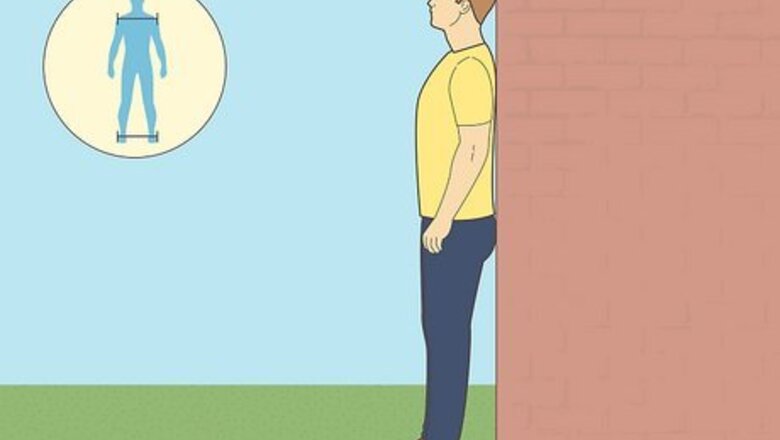
views
Establishing Proper Posture
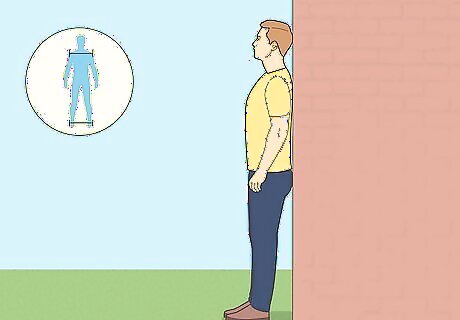
Back up against a wall. If you can find a spot of floor and wall that are flat and roughly perpendicular, you can easily assess your current posture and reset your body into proper alignment. Stand facing away from the wall, and slowly back up until you are standing in solid contact with it (but not leaning against it). Your feet should be shoulder-width apart, flat on the floor beneath you, and six inches off the wall.
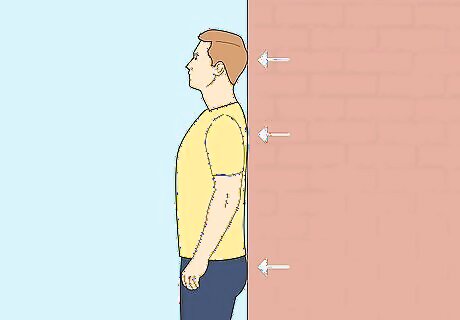
Notice what touches the wall. Ideally, you want three contact points between your body and the wall: the back of your head, your shoulder blades, and your buttocks. If you have poor standing posture, you may find that your mid-back (perhaps along with your buttocks) touches the wall first. Although less common, some people lean back too far instead of slouching forward, in which case your head alone may touch the wall first. If you are not making contact with your head, shoulder blades, and buttocks, reorient your upper body without moving your feet so that you are in a proper standing position.
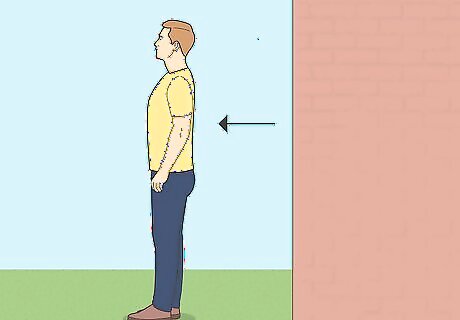
Step away and hold your positioning. Once you get a feel for standing up straight against the wall, try walking away while maintaining your proper upper-body posture. Before long, your body will want to revert to its former, familiar positioning. Try to focus on how proper positioning feels so that you can maintain it as long as possible. Once you feel the “slouch” returning, go back against the wall to re-establish your posture.

Remind yourself of the benefits. It is not a complicated process for most people to improve their posture, but it does take time and effort. It can be tempting to just go back to your familiar “hunch,” but keep in mind why it is well worth it to make the change. Although you may think of slouching as being more relaxed, it actually makes your muscles work harder, robbing energy from you in the process. It also makes it harder to breathe deeply and fully, which further reduces energy levels. The pressure placed on the vertebrae due to poor posture can lead to pinched nerves, stiffness, decreased flexibility and mobility, and even reduced sensation in the extremities. Good posture makes your muscles more limber; relaxes tension in your neck, shoulders, and back (which can reduce your stress level); and can even boost your mood and psyche. Studies indicate that people with good posture are on average more confident and energetic, and have better memory skills.
Maintaining Proper Posture
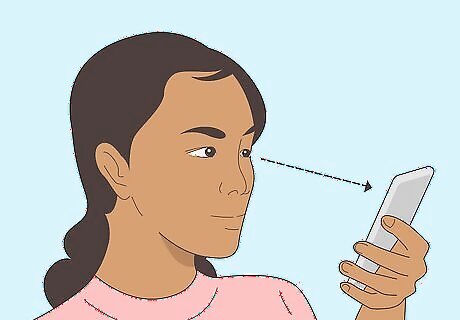
Practice good posture habits. Nowadays, whether we’re working, relaxing, or even walking around, we tend to be hunched over a glowing screen. Not surprisingly, this helps to instill poor posture habits. With active awareness and some simple changes, you can instill good habits instead. Focus on holding your cell phone at eye level when using it, instead of slouching over to look at it. This simple adjustment can do wonders for your posture. Take note of your posture any time you stand in front of a mirror or pass a reflective window. Remaining vigilant will help you retrain your body. When you have the option of standing or sitting, choose to stand. The human body is built for standing up, and standing is better for muscle development and overall health. Also, many bad posture habits are ingrained while sitting. Try to stand once every half hour if your requires you to sit for most of the day. When you do sit, focus on keeping your feet flat on the floor and your back flat against an upright, sturdy chair. Place your computer or other screens at eye level, and desk high enough that your elbows can rest on it while extended straight ahead.
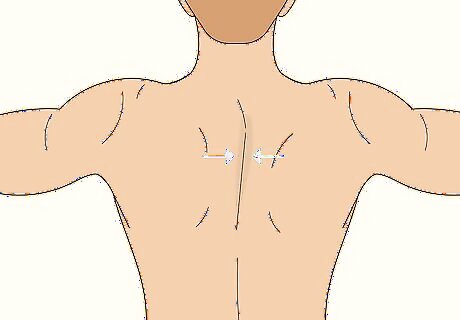
Exercise with shoulder-blade pumps. Achieving good posture isn’t just about good habits and proper positioning; you also need to strengthen the muscles that keep you in alignment. Stronger shoulder muscles, for instance, can make it easier to fend off your tendency to slouch. Bend your arms and hold them in front of you, at shoulder level and parallel to the floor. Squeeze your shoulder blades together. Don’t bring them together by pulling your outstretched arms apart. Instead, let your shoulder retraction pull your arms further apart. Focus on using the muscles in your upper back. Hold each squeeze for one or two seconds, then release and repeat for two minutes. Do this exercise at least once, or up to several times per day.
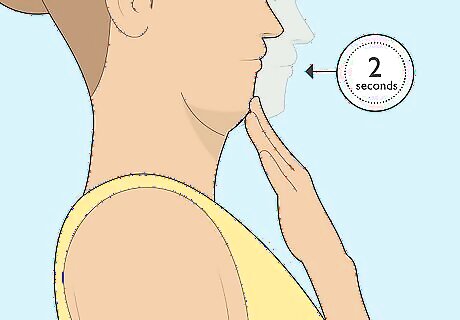
Try chin tucks and drops. It may sound odd at first, but one of the best ways to strengthen your neck muscles is to do exercises that focus on moving your chin. Once you try them, though, you’ll quickly notice how they stretch and utilize your neck muscles. For a sitting chin tuck, sit upright in a chair with your head in a neutral (proper upright seating) position. Tuck your chin inward, as if trying to retract it, without dropping it downward. Use a hand as a guide (but only push gently) if necessary. You should feel your neck muscles tense and release along with the maneuver. Hold for one or two seconds, release, and repeat for two minutes. To do a reclined chin tuck, lie flat on the floor on your back. Place your arms at your sides and bend your knees so that your feet are flat on the floor. Tuck your chin in (straight down toward the floor, not towards your chest) while keeping the back of your head on the floor. Hold, release, and repeat. For a traditional chin drop, sit upright in a chair with your feet flat on the floor and your hands resting on your thighs. Rotate your head downward so that your chin touches your chest (or comes as close as you can do comfortably). Try to relax your neck muscles as they stretch out. Make sure not to “round” your shoulders forward as you tuck your chin downward. Hold the position for thirty seconds, then release and repeat several more times. You can add greater stretching to a chin drop by placing one hand behind your head and gently pressing downward as you tuck your chin. Don’t press too hard, and stop if you feel unusual pain (that is, more than the typical “burn” from stretching your neck muscles).
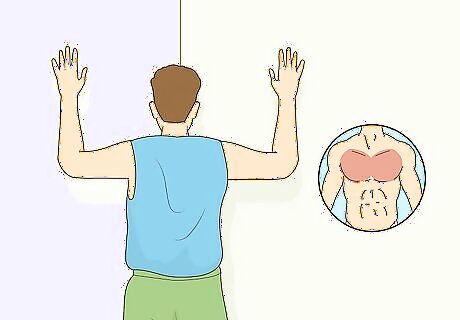
Strengthen your pectorals. Developing more muscle tone in the pectorals not only makes a guy look better with his shirt off, but it also helps men and women retain proper posture by keeping the shoulders from slouching forward. Stand facing a corner. Lift your arms to shoulder-height (parallel with the floor) with your arms bent at the elbow, so that one of your elbows and forearms rests on each of the two intersecting walls. Adjust your distance from the wall if necessary so that you are neither leaning in nor away from the wall in this starting position. While keeping your forearms and elbows against the walls, begin to lean forward until you feel a pulling sensation in your pecs. Hold this position for thirty seconds, return to the starting position, and repeat several times per session and one or more times per day. EXPERT TIP Laura Flinn Laura Flinn NASM Certified Personal Trainer Laura Flinn is a National Academy of Sports Medicine (NASM) Certified Personal Trainer, USA Olympic Weightlifting Sports Performance Coach and Certified Fitness Nutritionist, with an additional qualification as a TRX Suspension Trainer. Laura runs her own personal training program based in the San Francisco Bay Area and specializes in topics such as weight loss, muscle growth, cardiovascular training, and strength training. Laura Flinn Laura Flinn NASM Certified Personal Trainer Focus on exercises that stretch your chest and work your back. If you have bad posture, your chest muscles may be tight and could use some stretching to open them up. Your upper back muscles might also be underactive, and exercising them will make them stronger and correct your posture.














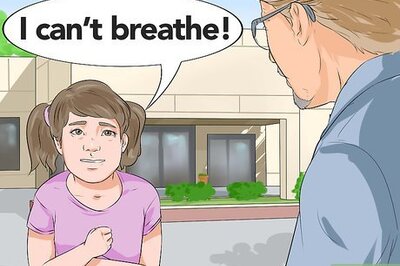





Comments
0 comment